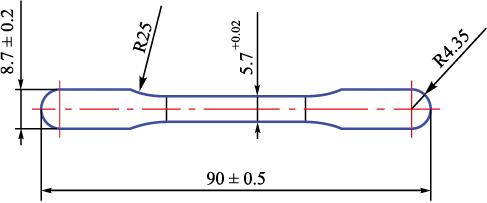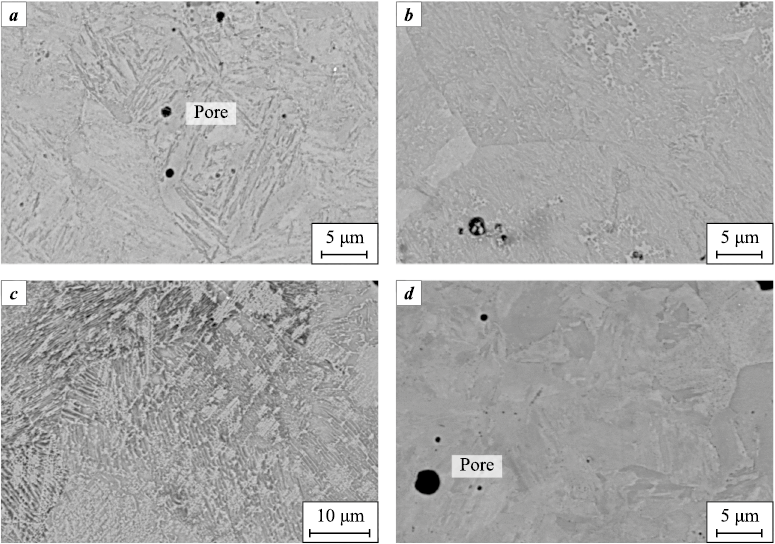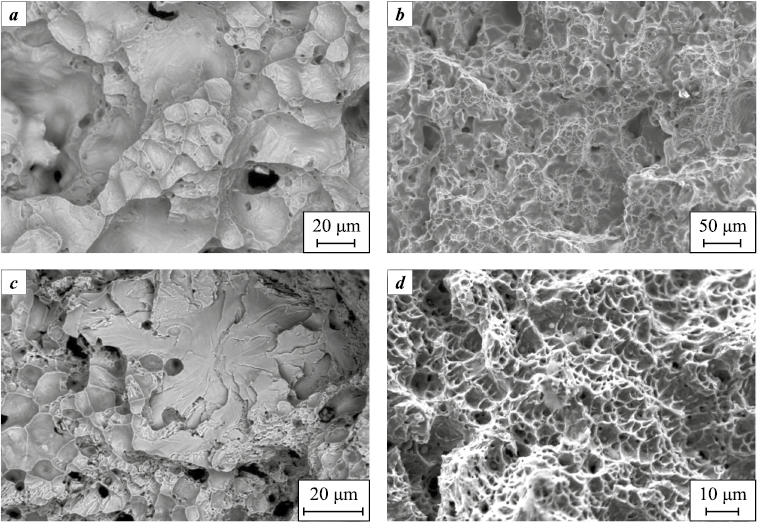Scroll to:
Effect of quenching and tempering on the structure and properties of hot-deformed powder steels with ultrafine particles
https://doi.org/10.17073/1997-308X-2025-1-15-22
Abstract
This study examines the effect of quenching and tempering on the structure and mechanical properties of hot-deformed powder steels containing ultrafine particles. The research analyzes the structural transformations and mechanical responses during quenching and tempering, focusing on the relationship between heat treatment conditions and the resulting material properties. The experiments involved variations in quenching temperature and tempering time, allowing the identification of optimal conditions for achieving a favorable combination of strength and ductility. The findings highlight the potential to achieve a homogeneous microstructure and high mechanical performance, making these materials suitable for high-load applications. This study underscores the significance of tailoring heat treatment parameters to control both microstructural and mechanical characteristics, thereby broadening the industrial applicability of powder steels.
For citations:
Egorov M.S., Egorova R.V., Mozgovoy A.V., Gantimurov K.V., Kovtun M.V. Effect of quenching and tempering on the structure and properties of hot-deformed powder steels with ultrafine particles. Powder Metallurgy аnd Functional Coatings (Izvestiya Vuzov. Poroshkovaya Metallurgiya i Funktsional'nye Pokrytiya). 2025;19(1):15-22. https://doi.org/10.17073/1997-308X-2025-1-15-22
Introduction
The properties of powder steels can be improved by complicating their composition and by applying thermal and thermochemical treatments. However, these methods of enhancing the properties of powder steels are characterized by certain challenges, primarily due to residual porosity and chemical and structural heterogeneity [1].
The influence of the structure of powder steels on the thermodynamics of new phase nucleation and transformation kinetics can be controlled through manufacturing technology. The formation of hot-deformed powder steels (HDPS) with minimal residual porosity aligns their critical points more closely with those of compact materials. The quenching temperature for powder steels is primarily determined by the critical points Ас1 (the temperature at which austenite begins to transform into pearlite or another phase during cooling and where ferrite starts transforming into austenite during heating) and Ас3 (the temperature at which ferrite begins to transform into austenite during heating – a key process for achieving the required steel properties), as well as the carbon content. HDPS are inherently fine-grained. Alloying with non-carbide-forming elements does not affect the tendency of austenite grains to grow at heating temperatures up to 1100 °C. This feature expands the temperature range for quenching; for HDPS with 0.5 % carbon content, this range is 825–845 °С [2–5].
The aim of this study is to investigate the quenching and tempering regimes to determine the optimal mechanical properties of hot-deformed powder steels containing ultrafine particles.
Materials and methods
The study utilized domestic powders of grades PZhRV 2.200.26 (TU 14-1-5365-98, water-atomized and reduced iron powder) and N4D2M (TU 14-5402-2002, alloyed powder) produced by Severstal PJSC (Cherepovets, Russia) [4; 5]. Ultrafine additives of silicon nitride (Si3N4 ) and nickel oxide (NiO) produced by Plazmoterm (Moscow, Russia) [6] were added to the charge.
Before use, the powders were analyzed using the Analysette 22 MicroTecplus universal laser particle size analyzer (Fritsch, Germany) and the Beckman Coulter AU480 submicron particle analyzer (USA). The charge was prepared using an RT-NM05S twin-cone mixer (Taiwan) and an Assonic SPC ultrasonic station (China) for sieving and mixing powders with ultrafine particles. Static cold pressing was performed on a TS0500-6 hydraulic press (China) with a maximum load capacity of 50 tons using laboratory dies. Homogenizing sintering was carried out in the heat treatment laboratory of the “Materials Science and Metal Technology” department of DSTU in an SNOL 6.7/1300 muffle electric furnace (AB UMEGA, Lithuania) at temperatures ranging from 900 °C to 1150 °C in a protective gas atmosphere of dissociated ammonia. The sintering time ranged from 15 to 180 min. Subsequent heat treatment of the hot-deformed powder steels was conducted in the same furnaces.
Dynamic hot pressing (DHP) of the billets was performed on a K2232 crank press (Russia) with single-action operation. Before the DHP operation, powder billets were heated in a muffle electric resistance furnace (950–1150 °C) in a dissociated ammonia atmosphere. The furnace temperature was monitored using a platinum-palladium thermocouple [7].
Tensile tests were conducted in accordance with GOST 18227-85 using an MGS-V15 servo-hydraulic floor testing machine in automatic mode with a personal computer. Fig. 1 shows the diagram of the sample subjected to testing.
Fig. 1. Technical drawing of the sample for tensile testing |
The hardness of the samples was measured using a Rockwell hardness tester (TK-2M, Tochmashpribor, Ivanovo, Russia) with diamond cone indentation under a total load of 1471 N.
The samples of PZhRV 2.200.26 + 0.5 % C and N4D2M + 0.5 % C were subjected to quenching followed by tempering after hot re-pressing at t = 1150 °С, with the addition of ultrafine particles (2 % NiO, 0.1 % Si3N4 ) to each material. Cooling was performed in water and oil, with cooling rates at the temperature of minimum austenite stability being 600–500 °C/s (in water) and 150–100 °C/s (in oil), respectively. The chemical composition of the studied powders, the characteristics of the ultrafine particles, and the technology for producing sintered samples are described in detail in [2].
Results and discussion
Quenching of hot-deformed powder steels (HDPS) makes it possible to obtain a homogeneous martensitic structure with high hardness (HV = 7.5 GPa). This is due to the low porosity and favorable structure formed during hot pressing.
Fig. 2 shows the microstructure of HDPS based on PZhRV 2.200.26 powder containing 0.5 % C + 2 % NiO. The martensitic structure is clearly defined, with a small number of pores up to 3 µm in size. This quenched steel structure does not contain ferrite or retained austenite, confirming that the quenching process was conducted correctly [8; 9]. The hardness of the quenched HDPS at a quenching temperature of 835 °С is presented in Table 1.
Fig. 2. Martensite of hot-deformed powder steel of PZhRV grade 2.200.26 + 0.5 % C + 2 % NiО
Table 1. Hardness (HRC) of quenched HDPS
| ||||||||||||||||||||||||||||||
Modification of steels with silicon nitride increases hardness after quenching. The final formation of the structure and properties of HDPS occurs during tempering. The effect of tempering temperature on the mechanical properties of HDPS is presented in Table 2.
Table 2. Dependence of mechanical properties of HDPS on tempering temperature
|
For all the studied materials, a similar trend in property changes is observed: as the tempering temperature increases, the ultimate strength (σv ) and hardness (HRC) of the steels decrease, while the ductility parameter (ψ) increases, reaching its maximum t = 550 °С. At this temperature, the overall set of mechanical properties is superior to those of the initial and annealed steels [7–9].
The microstructures of quenched and tempered HDPS N4D2M + 0.5 % C + 2 % NiO are shown in Fig. 3.
Fig. 3. Microstructure of H4D2M + 0.5 % С + 2 % NiO after quenching |
Thus, quenching and tempering allow for achieving the desired structure of HDPS [9–11]. The level of mechanical properties of HDPS depends on the quality of interparticle bonding formed during the sintering and hot re-pressing stages. If this bonding is incomplete, it is not possible to improve mechanical properties through strengthening heat treatment [11; 12].
To monitor the chemical composition of the powder steels obtained after heat treatment (quenching and tempering), a micro X-ray spectral analysis was performed using a scanning electron microscope (S-3400N, Hitachi, Japan) [12; 13]. The results are presented in Fig. 4.
Fig. 4. Results of micro-X-ray spectral analysis of powder steel H4D2M + 0.5 % C + 2 % NiO |
The presence of all alloying elements in the powder steel after heat treatment was verified through micro-X-ray spectral analysis [7; 10; 12].
Fractographic analysis using the S-3400N scanning electron microscope highlighted the characteristic features of HDPS fractures following heat treatment (quenching and tempering). The fracture surfaces of the quenched and tempered HDPS samples are presented in Fig. 5.
Fig. 5. Fractographs of powder steels with ultrafine particles after tempering |
An analysis of the fractographs revealed that the dominant features on the fracture surfaces of HDPS tempered at t = 250 °С are intergranular and transgranular cleavages, appearing at different levels and distinguished by varying sizes of the crack propagation zones [14–16]. In Fig. 5, a and c steps on large cleavage elements are clearly visible, giving the structure a river-like pattern – a characteristic feature of intergranular fracture. On smaller facets, smooth surfaces formed by crack propagation along crystallographic planes are observed, which are typical of transgranular cleavage [17–20]. Discontinuities in both intergranular and transgranular cleavage zones make it difficult to identify the preferred site of crack initiation. This observation indirectly suggests a balance of interatomic bonding forces within grains and along grain boundaries, indicating the successful formation of intragranular bonding during HDPS production [2; 12].
Conclusion
The study examined the effects of quenching and tempering on the structure and properties of HDPS with ultrafine particles. Maximum hardness at a quenching temperature of 835 °С was observed in steels with compositions PZhRV 2.200.26 + 0.5 % C + 0.1 % Si3N4 (HRC = 54) and N4D2M + 0.5 % C + 0.1 % Si3N4 (HRC = 55). Modifying steels with silicon nitride improved hardness after quenching. For these steels, maximum ultimate strength values were recorded at a tempering temperature of 250 °С: σv = 1230 MPa (PZhRV 2.200.26 + 0.5 % C + 0.1 % Si3N4 ) and σv = 1450 MPa (N4D2M + 0.5 % C + 0.1 % Si3N4 ). At 550 °С, these steels exhibited maximum ductility indicators: ψ = 35 % (PZhRV 2.200.26 + 0.5 % C + 0.1 % Si3N4 ) and ψ = 34 % (N4D2M + 0.5 % C + 0.1 % Si3N4 ). The addition of 0.1 % Si3N4 increased ultimate strength at 250 °С by 50 MPa for PZhRV 2.200.26 + 0.5 % C and by 30 MPa for N4D2M + 0.5 % C. Adding 2 % NiO to both materials slightly improved strength properties (by 10–15 MPa).
For HDPS tempered at 550 °С, the fracture surfaces predominantly displayed a dimpled morphology, with individual dimples ranging in diameter from 8 to 20 µm. The clear resolution of dimple depths and ridge heights indicates the material’s high capacity for microplastic deformation at the crack propagation site [19; 20].
This study demonstrates that strengthening heat treatment is a key tool for enhancing the mechanical properties of hot-deformed powder steels. By carefully adjusting quenching and tempering conditions, it is possible to improve the material’s strength, ductility, and hardness. Managing mechanical properties depends on the effective formation of intragranular bonding during production, which optimizes the microstructure and significantly enhances the performance of the final product. The combination of heat treatment and bonding control offers a promising pathway for advancing the quality and functionality of powder steels. These findings open new opportunities for developing materials with tailored properties, which are essential for modern mechanical engineering and other high-tech industries [10; 12].
References
1. Kuhn H.A., Ferguson B.L. Powder forging. Princeton, New Jersey: MPIF, 1990. 270 p.
2. Egorov M.S., Egorova R.V., Lopatin V.Yu. Phase transformations in powder sintered steels during cooling. Safety of Technogenic and Natural Systems. 2024;8(3):67–77. (In Russ.). https://doi.org/10.23947/2541-9129-2024-8-3-67-77
3. Bernshtein M.L., Kaputkina L.M., Konyukova E.V., Nikishov N.A., Shakhkerimov R.N. Changes in the structure of thermomechanically hardened austenite under the effect of temperature and deformation. Russ. Metallurgy. Metally. 1985;(1):80–88.
4. Chen N., Luo R., Xiong H., Li Z. Dense M2 high speed steel containing core-shell MC carbonitrides using high-energy ball milled M2/VN composite powders. Materials Science and Engineering: A. 2020;771:138628. https://doi.org/10.1016/j.msea.2019.138628
5. Chaus A.S. Structural and phase changes in carbides of the high-speed steel upon heat treatment. The Physics of Metals and Metallography. 2016;117(7):684–692. https://doi.org/10.1134/S0031918X16070048
6. Plasmotherm LLC. Metal Nanopowders. URL: http://plasmotherm.ru/catalog/metal/item_4.html (accessed: 18.05.2024). (In Russ.).
7. Dorofeev Yu.G., Dorofeev V.Yu., Kochkarova H.S. Features of the distribution of microalloying elements in hotly deformed iron-based powder materials and their effect on the quality of interparticle splicing. Metal Science and Heat Treatment. 2013;(8):35–39. (In Russ.). https://doi.org/10.1007/s11041-013-9650-4
8. Pelletiers T.W., Daye W.K. Copper-infiltrated steels. Powder Metallurgy. 1998;(7):326–330. https://doi.org/10.31399/asm.hb.v07.a0006076
9. Hendrickson A.A., Machmeier P.M., Smith D.W. Impact forging of sintered steel performs. Powder Metallurgy. 2000; 43(4):327–344.
10. Panov V.S., Skorikov R.A. The influence of nanosized dopants on the structure and properties of powder carbon steels. Nanotekhnologii: nauka i proizvodstvo. 2015; 35(3):40–45. (In Russ.).
11. Egorov M.S., Egorova R.V., Kovtun M.V. Influence of carbon content on the formation of a contact interparticle surface during hot post-pressing. Safety of Technogenic and Natural Systems. 2023;7(2):90–101. (In Russ.). https://doi.org/10.23947/2541-9129-2023-7-2-90-101
12. Egorov M.S. Scientific and technological principles of interparticle splicing of sintered and hot-deformed powder steels modified with ultrafine particles. In: Proceedings of the 16th International Scientific and Technical Conference “New materials and technologies: powder metallurgy, composite materials, protective coatings, welding” (Minsk, 22–24 May 2024). Minsk: Publ. house “Belarusskaya nauka”, 2024. P. 63–67. (In Russ.).
13. Dyachkova L.N., Dechko M.M. The effect of nanodisperse additives on the structure and properties of powdered carbon and high-chromium steel. Nanotekhnologii: nauka i proizvodstvo. 2015;35(3):5–14. (In Russ.).
14. Dorofeyev V.Y., Sviridova A.N., Samoilov V.A. Formation of structure and properties of hot-deformed powder steels microalloyed with sodium and calcium in the process of thermal and thermomechanical treatment. Russian Journal of Non-Ferrous Metals. 2021;62(6):723–731. https://doi.org/10.3103/S1067821221060080
15. Nasibulin A.G., Queipo P., Shandakov S.D., Brown D.P., Jiang H., Pikhista P.V., Kauppinen E.I. Studies of mechanism of single-walled carbon nanotube formation. Journal of Nanoscience and Nanotechnology. 2006;6(5): 1233–1246. https://doi.org/10.1166/jnn.2006.340
16. Dorofeyev V.Y., Sviridova A.N., Berezhnoy Y.M., Bessarabov E.N., Kochkarova K.S., Pustovoit V.N., Sviridova S.V. Structure and properties of hot-deformed powder steels microalloyed by aluminium. IOP Conference Series: Materials Science and Engineering. 2020; 862(2):022045. http://doi.org/10.1088/1757-899X/862/2/022045
17. Gilardi R., Alzati L., Oro R., Hryha E., Nyborg L., Berg S. Reactivity of carbon based materials for powder metallurgy parts and hard metal powders manufacturing. Journal of the Japan Society of Powder and Powder Metallurgy. 2016;63(7):548–554. https://doi.org/10.2497/jjspm.63.548
18. Rojek J., Nosewicz S., Mazdziarz M., Kowalczyk P., Wawrzyk K., Lumelskyj D. Modeling of a sintering process at various scales. Procedia Engineering. 2017;177:263–270. https://doi.org/10.1016/j.proeng.2017.02.210
19. Gostev A.S., Gosteva E.G., Gulevsky V.A. The role of nanopowders in alloy modification. Young Scientist. 2010;22(11):53–55. (In Russ.).
20. Eremeeva Zh.V., Nitkin N.M., Sharipzyanova G.H. Features of the application of nanoscale carbon and chromium powders to the processes of charge preparation and pressing of powder steels. Izvestiya MGTU “MAMI”. 2011;12(2):123–127. (In Russ.).
About the Authors
M. S. EgorovRussian Federation
Maxim S. Egorov – Cand. Sci. (Eng.), Associate Professor, Head of the Department of Materials Science and Metal Technology
1 Gagarina Sq., Rostov-on-Don, 344003 Russia
R. V. Egorova
Russian Federation
Rimma V. Egorova – Cand. Sci. (Eng.), Associate Professor, Department of Cybersecurity of Information Systems
1 Gagarina Sq., Rostov-on-Don, 344003 Russia
A. V. Mozgovoy
Russian Federation
Andrey V. Mozgovoy – Cand. Sci. (Eng.), Associate Professor, Vice-Rector of Strategic and Digital Development
1 Gagarina Sq., Rostov-on-Don, 344003 Russia
K. V. Gantimurov
Russian Federation
Kirill V. Gantimurov – Graduate Student
1 Gagarina Sq., Rostov-on-Don, 344003 Russia
M. V. Kovtun
Russian Federation
Mark V. Kovtun – Head of the Department of Road Troops of the Military Training Center
1 Gagarina Sq., Rostov-on-Don, 344003 Russia
Review
For citations:
Egorov M.S., Egorova R.V., Mozgovoy A.V., Gantimurov K.V., Kovtun M.V. Effect of quenching and tempering on the structure and properties of hot-deformed powder steels with ultrafine particles. Powder Metallurgy аnd Functional Coatings (Izvestiya Vuzov. Poroshkovaya Metallurgiya i Funktsional'nye Pokrytiya). 2025;19(1):15-22. https://doi.org/10.17073/1997-308X-2025-1-15-22






































